 Our mint patch has taken over the herb garden. The top canopy is almost chest-level, like a hedge. It has engulfed neighboring oregano and chives. Minty sucker scouts are popping up yards away. We act now or... deal with a worse situation next year. The strategy? Eat it.
I'll be cooking a few recipes with mint to keep the invasion in check until we feel like bringing out the big shovels. I did a stint of digging a couple of weeks ago to transplant a section of this leafy tyrant to a plot by the mailbox.
Our mint patch has taken over the herb garden. The top canopy is almost chest-level, like a hedge. It has engulfed neighboring oregano and chives. Minty sucker scouts are popping up yards away. We act now or... deal with a worse situation next year. The strategy? Eat it.
I'll be cooking a few recipes with mint to keep the invasion in check until we feel like bringing out the big shovels. I did a stint of digging a couple of weeks ago to transplant a section of this leafy tyrant to a plot by the mailbox.
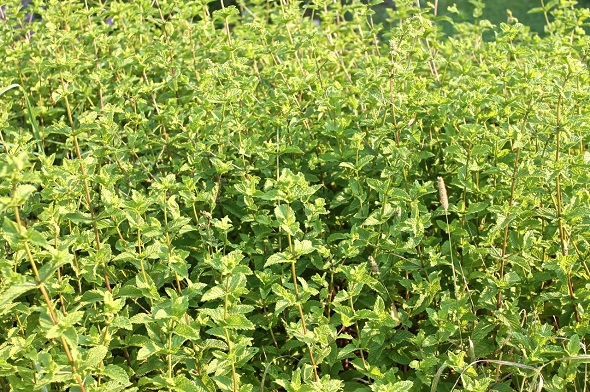 This first recipe is a simple tabbouleh, which can be made with bulgur or couscous--both are good. Some people find tabbouleh bland. I keep it interesting by toasting the couscous/bulgur.
This first recipe is a simple tabbouleh, which can be made with bulgur or couscous--both are good. Some people find tabbouleh bland. I keep it interesting by toasting the couscous/bulgur.
For even more flavor I use the deliciously crumbly Mira River Feta by The Wandering Shepherd, a Cape Breton artisan cheese maker best known for his terrific ewe milk cheeses. For this recipe, I'm also using Speerville Organic Couscous.
Serves 6-8
Ingredients
• 2 cups couscous • 4 cups water • 1 cup mint, chopped • 1 cup feta, crumbled • 2 medium tomatoes, roughly chopped • 1 onion, chopped • 5 tablespoons olive oil • small bunch of chives, chopped • juice of half a lemon • salt + ground black pepper
In a small skillet, sauté the onion in olive oil for about 5 minutes. Set aside.
In a large cast iron pot or skillet, toast the couscous on medium heat, stirring often, until most of it is browned. Meanwhile you can bring the water to a simmer. Remove from heat.
Pour the hot water over the couscous, cover, and let stand for 5 minutes.
Transfer to a large bowl, and stir in the sautéed onions, mint, feta, tomatoes, chives, lemon juice, and season with salt and pepper.
Eat hot or let it cool down. Top with chopped mint.
Will keep in the fridge for 3-4 days.


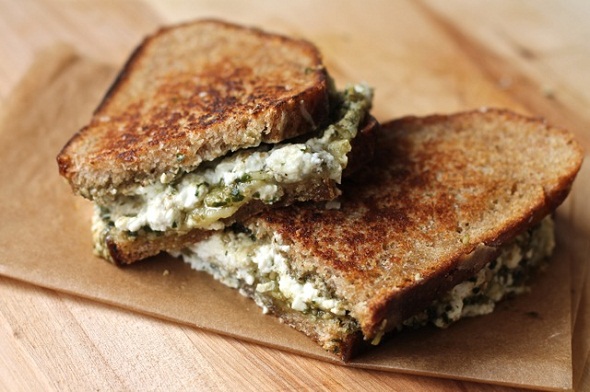 One of my all-time comfort food favorites is the grilled cheese sandwich. No surprise there. This is my second post on that heavy-sitting delicacy. One of the three cheeses here is my own, a homemade goat cheese. Cheese is easier to make than you'd think. You should check it out. The other cheeses are the cheddar and parmesan leftover from my Pinwheel Loaf. Let's hope that one day I am making all my own cheeses. For now, one at a time. The whole wheat bread is also homemade and I'll probably post the recipe here because the results are well worth it -- depth of flavor and a nice crust.
Instead of using pine nuts in the pesto, which come most often from the far end of the world, I used sunflower seeds. They're just as good, cheaper, and they grow closer to home. Use any herbs that are available; pesto is also good with parsley, chervil, and even chives.
One of my all-time comfort food favorites is the grilled cheese sandwich. No surprise there. This is my second post on that heavy-sitting delicacy. One of the three cheeses here is my own, a homemade goat cheese. Cheese is easier to make than you'd think. You should check it out. The other cheeses are the cheddar and parmesan leftover from my Pinwheel Loaf. Let's hope that one day I am making all my own cheeses. For now, one at a time. The whole wheat bread is also homemade and I'll probably post the recipe here because the results are well worth it -- depth of flavor and a nice crust.
Instead of using pine nuts in the pesto, which come most often from the far end of the world, I used sunflower seeds. They're just as good, cheaper, and they grow closer to home. Use any herbs that are available; pesto is also good with parsley, chervil, and even chives.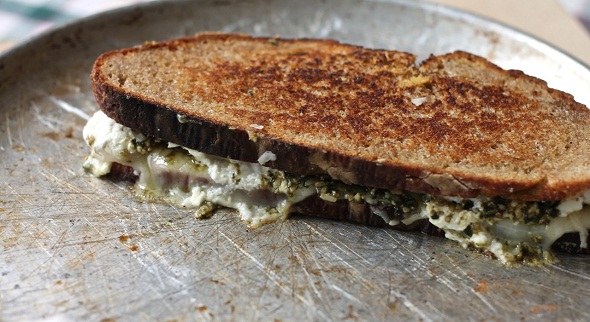
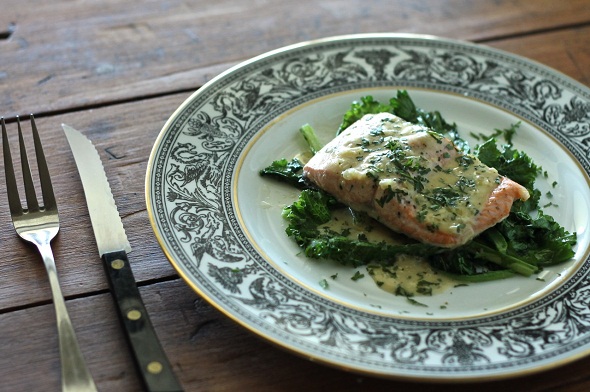 Another herb growing back from last year's garden is chervil. I use Chervil to give a dose of light liquorice flavor to poultry and fish. For this recipe, I paired it with trout and added another one of my favorite ingredients, mustard. I kept it simple. The sauce takes only a few minutes to throw together and the fish takes ten minutes to cook.
A short note on overcooking salmon or trout: don't. Fish are much better on the medium-rare side. When overcooked they tend to dry out and lose a lot of flavor. The same rule applies to meats also. Less juice, less taste.
I had steelhead trout, but rainbow or speckled will do just fine. For a side, I sautéed mustard greens to give the mustard back its leaves.
Another herb growing back from last year's garden is chervil. I use Chervil to give a dose of light liquorice flavor to poultry and fish. For this recipe, I paired it with trout and added another one of my favorite ingredients, mustard. I kept it simple. The sauce takes only a few minutes to throw together and the fish takes ten minutes to cook.
A short note on overcooking salmon or trout: don't. Fish are much better on the medium-rare side. When overcooked they tend to dry out and lose a lot of flavor. The same rule applies to meats also. Less juice, less taste.
I had steelhead trout, but rainbow or speckled will do just fine. For a side, I sautéed mustard greens to give the mustard back its leaves.
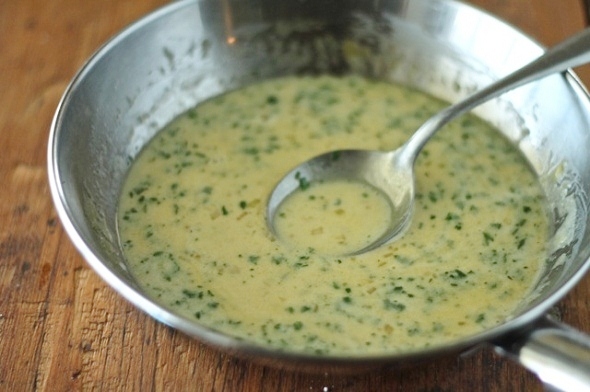
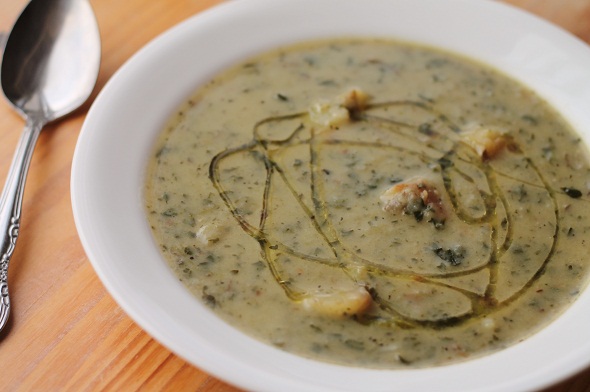 Soup days are not over here on Cape Breton Island. We've had a week of rainy-windy weather, interrupted here and there by brief periods of sun. Cook-outs are just around the corner, but there's no rush. Just fill me up another bowl of that watercress soup. You can eat watercress raw as a salad leaf, or you can cook it. I made a soup with watercress and some roasted potatoes. I roasted the potatoes with herbs simply to give them (and the soup) a greater depth of flavor. You could also use any form of leftover potatoes--a rare sort, but hey, that's us.
To make a good soup you need a good stock. That said, I really encourage you to
Soup days are not over here on Cape Breton Island. We've had a week of rainy-windy weather, interrupted here and there by brief periods of sun. Cook-outs are just around the corner, but there's no rush. Just fill me up another bowl of that watercress soup. You can eat watercress raw as a salad leaf, or you can cook it. I made a soup with watercress and some roasted potatoes. I roasted the potatoes with herbs simply to give them (and the soup) a greater depth of flavor. You could also use any form of leftover potatoes--a rare sort, but hey, that's us.
To make a good soup you need a good stock. That said, I really encourage you to 